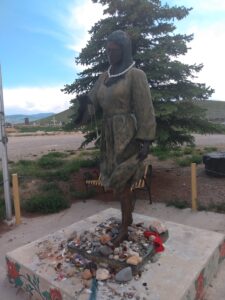Most of us learned of Sacajawea in history class as the Indian that helped Lewis and Clark explore the newly acquired Louisiana Territory. we have visited several of the Lewis and Clark sites including Pompey’s Pillar. That site was named after Sacajawea infant son who traveled with them on the expedition.
Sacajawea was a Shoshone native who had been captured at age 12 by another tribe, the Hidatsa. They bartered or sold her to a French trader who made her his second wife.
When the Lewis and Clarke expedition reached the Hidatsa-Mandan settlement, they met Sacajawea and her husband. They realized that the trader and his Indian wife would make an excellent addition to the expedition as most of their group spoke only English except for one that could speak French. Sacajawea’s husband spoke French and Hadasta and she spoke Hadasta and Shoshone
After the expedition, Sacajawea and her trader husband tried farming but did not do well at it. Sacajawea died at the age 25 most likely from Typhoid fever after the birth of her second child.
Her grave site is located on the Wind River reservation, which was on our route to the Grand Tetons.

It is ironic that the reservation that holds the remains of one of the most well known and resourceful Indian woman is also and area that is unsafe for native women and suffers from jurisdictional problems bring perpetrators to justice. We accidentally found the movie Wind River that put a spotlight on issue of women’s safety and jurisdiction on the reservation while we stayed at the hotel in Casper.